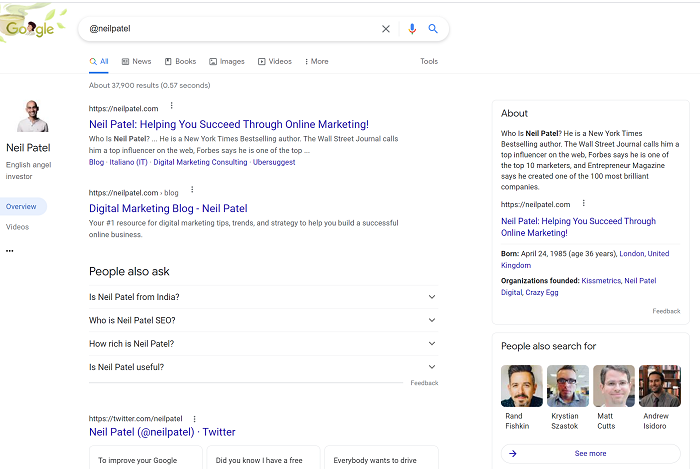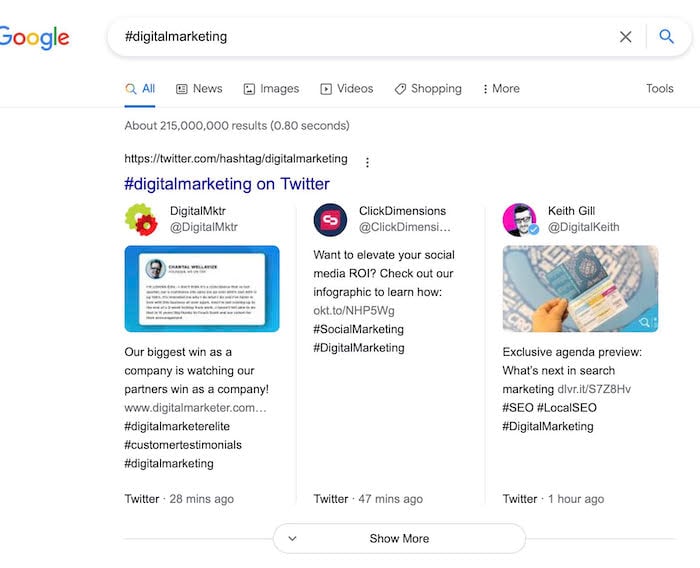
Do you consider yourself a Google expert? Think you know all the ins and outs of the search behemoth?
If you answered yes to either of those questions, you might be in for a surprise.
Google contains myriads. The search giant constantly evolves its algorithms and offerings, from secret search functions to in-house SEO guides.
Read on to learn more about Google’s secrets.
1. Google Has Advanced Search Functions: Boolean Operators
We’re all incredibly familiar with the Google search bar, given that 84 percent of us admit to searching Google at least three times a day. However, the search engine also comes equipped with some pretty cool, advanced search functions many don’t know about. These built-tools range from a hashtag search function guides that enable users to optimize for search engine optimization (SEO) and everything in between.
Below, we break down the four most useful secret Google search functions so you can start mastering these secret tricks.
Search for Similar Google Results With Related
Adding “related:” to your search terms lets you include similar or identical topics. This can be beneficial in broadening your search but allow you to keep the results in the same thematic area.
This search feature can aid online business owners or marketers in identifying competitors. By assessing business type, content, and category, Google can show vendors offering similar products and services. This often makes research into competitor search ranking, social strategy, and other marketing functionality easier.
Searching Social Media Profiles and Mentions With Google
With over 49 percent of the global population using social media, it’s safe to say there’s an overwhelming amount of profiles to sort through.
With the social media search Google secret, you can use the @ symbol followed by the handle of an account. Google will compile results for that user, including web pages and tweets.

You can also narrow your search by typing those terms followed by the site you want to search, like Twitter. This could show you the person’s account, mentions of their account, and accounts using similar handles or owned by people with the same actual name.
This can help you isolate mentions of competitors or brands you want to explore further.
Use Google to Search for Hashtags
Much like the above @ function, you can find much more than profiles with Google search functions.
Use the # symbol to aggregate hashtag results, including the social presence associated with the words or phrases.
For example, if you search #digitalmarketing and change the search date to the past 24 hours under “Tools,” you’ll see the most recent posts across social media that discuss digital marketing.

If you want a tight lens, change the result type to verbatim using quotation marks—”#digitalmarketing”—to exclusively see the use of the hashtag.
This search functionality lets marketers see which keywords align with your brand’s message while simultaneously investigating how competitors use social media.
Google Lets You Access a Site’s Cache
From identifying how frequently your site is crawled to relaying information about a page that’s currently down, you can learn a lot from caches.
To access the saved copy of a website, simply use the cache: search command before a site’s URL.
You can view the most recent version of a site within the cache copy, so don’t expect to find a years-old draft.
Within the cached copy, you can view the full version, text-only version, or view source. You will also see the timestamp and snapshot taken by Google.
2. Google Makes Thousands of Updates Each Year
While in its infancy, Google didn’t make many updates to its algorithms annually. Now, the algorithm is updated countless times a year.
Why should you care about this (fairly open) Google secret?
Updates mean changes to how pages display in the search engine result pages (SERPs) and can impact your search visibility.
While these updates have historically ranged from removing spam to ad placement on the SERPs, there’s a significant update on the horizon impacting how marketers gather information about their intended audience.
Google plans to remove all third-party cookies from its engine. Used as a tool for tracking individual movement across the web, cookies have not only long been a marketer’s best friend but also a security threat.
While cookie removal is a massive update, tons of additional updates can impact your digital strategy in other ways.
To stay ahead of these updates, take steps to ensure that you build agile, editable sites and pages that can roll with the changes, setting you up for digital success.
3. Google Knows When Users Exit a Page [Bounce Rate]
Have you struggled to boost email sign up, increase site search traffic, or get more leads?
If you answered yes, the root cause of your problem may be your bounce rate.
Your bounce rate refers to the number of individuals who visit your landing page and leave without conducting any other interaction.
Bounce rates are important metrics because they allow you to understand audience on-page behavior.
And Google has a clear record of this behavior through Google analytics.
If you’re experiencing high bounce rates and struggling to achieve your marketing goals, don’t fret. There are several steps you can undertake to reduce your bounce rate:
Improve Content Readability
Does your content look like one big chunk?
If so, you need to break it up.
Ideally, your content should be quick and consumable. Here are a few tips for making your pages more readable:
- Use images to break up the labor of reading.
- Use quotes to underscore reliability and break up the text.
- Use subheading.
- Bold keywords.
- Ask questions to engage readers.
- End your landing page or content with a subheading titled conclusion.
Write Strong Meta Descriptions
Meta descriptions are HTML attributes that explain what a searcher can anticipate finding on a given page. Search engines use these descriptions to determine what your page is about.

Ideally, meta descriptions should be 155 characters long. If you exceed this length, the searcher will see an ellipsis (…) at the end of the description. This can result in a higher bounce rate since your site may not have been adequately described.
To optimize your meta descriptions, try to reach that ideal character length of 155 and include relevant keywords.
Use Interactive Content
Are you looking to engage site visitors? There’s no better strategy than using interactive content.
Interactive content entices users to take action rather than simply bouncing from your site. This way, you can lead visitors to explore your site to learn more about your organization.
Examples of interactive content include infographics, e-books, lookbooks, quizzes, and checklists, all of which create and maintain engagement.
4. Google Releases Their Own SEO Guides
While some things at Google may seem hidden, Google releases its own SEO guides.
These tools vary depending on skill level and familiarity and even include a starter guide and developer guide.
These guides cover nearly everything you need to know about succeeding with SEO on Google.
5. Google Holds Secret Conferences
For the last decade, Google has hosted an event dubbed Google Camp during the summer.
Don’t let the cutesy name fool you—this isn’t a bootcamp for coders or developers.
It’s a star-studded meeting of the minds that occurs during the summer months.
Annually themed, the camp has covered humanitarian topics like global warming and education.
You can find former presidents and current starlets, fashion designers, and tech leaders attending these events.
And while admittance to this event is highly selective (not to mention expensive), attendees allegedly enjoy in-depth conversation and relaxation.
6. Google Is Loaded With Fun Easter Eggs
While Google may be the world’s most-used search engine, it is also arguably the world’s most fun search engine. Chock full of Easter eggs that range from solitaire to the functionality to create a heart-shaped graph, you can find a way to entertain yourself when taking a break from customer research. We break down our current three favorite Easter eggs below.
Animal Sounds
Whether you’re teaching your kids the nuances among varying animal sounds or simply want to have some nature-themed time, this secret feature is endlessly delightful.
To access Google’s animal sounds feature, enter the search phrase “animal sounds” into the search bar and let the fun begin.
Tic Tac Toe
If you’re in search of another distracting Google Easter egg and are craving nostalgia, you can try your hand at a classic game of X’s and O’s.
Simply enter the term tic tac toe into the search bar, and you’ll be on your way to a competitive game with Google AI.
Coin Flip
Found yourself sitting with a yes or no question that the flip of a coin can only decide?
If you don’t have a quarter on hand, don’t fret. Google has one for you. Simply enter the phrase flip a coin into the search bar, and you’ll have your answer.
7. Google Provides Directions Directly From the Search Bar
While you probably use Google Maps in your day-to-day life, you can also score directions to any location directly from the search bar. For example, simply type “directions to [destination] from [location]” into the search bar, and Google will provide step-by-step directions. You can even choose whether you’d prefer directions by car, public transit, or foot.
8. Google Enables Search Within Websites
If a website doesn’t include a search function, don’t fret. With Google, you can search a website’s content for a specific query. Simply add site:[website] to the beginning of your search, and you’ll be directed to results from that particular site rather than the entirety of the web.
9. Google Enables Search for Movies, Books, and News
While most Google users know how to conduct image and video searches, did you know you can further vary your search results by medium?
If you’re searching for a book, click the menu item entitled “More.” From here, you can select books, news, or movies and remove any other search clutter that gets in the way of your aim.
10. Define Your Number of Search Results
While we all aspire to land on Google’s first page, sometimes the information you need doesn’t land there. To view more search results, select “Settings” below the right-hand of your search bar on the results page. From here, you can adjust the number of search results that appear.
Google Secrets Frequently Asked Questions
Does Google Have Secret search functions?
Yes! While you may be using standard search queries in the search bar, Google possesses deeper functionality than meets the eye.
Does Google update its search algorithm, and should I care?
Yes, and yes. Google makes thousands of updates to its search algorithm annually. These updates can significantly impact how your site manifests on the SERPs.
How can I keep up with Google’s changing algorithm?
While the answer here is two-fold, we believe that the best offense is a good defense. While many of Google’s more extensive changes are publicized before they go into effect, some are not. By building an adaptive and agile site, you can prepare for whatever updates come your way.
Does Google Really Hold Secret Conferences?
Yes, they do. Every year, guests gather in the summer at a themed retreat focused on a humanitarian issue.
Google Secrets: Conclusion
Regardless of whether you’re a digital marketer or a business owner, it never hurts to learn more about the search engine that drives the majority of traffic to your website.
If we’re honest, we all want more legitimate site visitors, better optimized SEO, and high-converting web pages, right?
As you learn more about Google secrets, you can use them to your advantage.
That SEO guide? We would suggest getting very familiar with its contents.
And while you may not find yourself in Southern Italy at Google Camp, you will have a much better chance at finding your site ranking on the first page of Google’s SERPs.
What Google secrets do you know?
from Neil Patel https://ift.tt/3mPDCK4